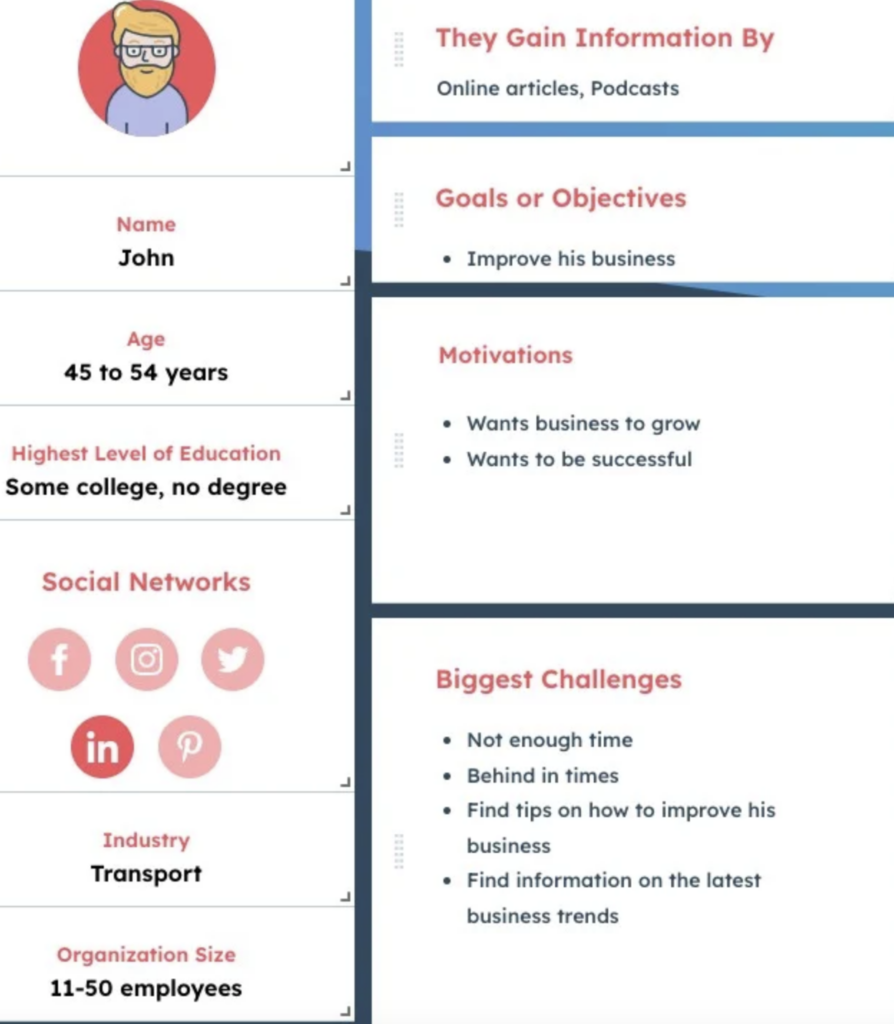How to Create an Effective Buyer Persona: Examples + Template
An essential step in improving conversion rates is identifying your ideal buyer persona. Creating this buyer profile helps you gain a better understanding of your target market. As a result, you also get ideas on how to better meet your customers’ specific needs.
It can be challenging to create the ideal buyer persona at first. But once you have this nailed down, it can be a powerful tool for ensuring you’re prioritizing the customer. You may even find that you have to create more than one buyer persona to represent your target market more accurately.
In this article, you’ll learn more about the buyer persona and view some great examples. You can also get some ideas from the buyer persona template listed below.
What is a buyer persona?
A buyer persona, also called a customer persona, is a fictional characterization of your business’s types of customers. It includes various demographic information about your target market, like the following:
- Gender
- Income
- Age bracket
- Interests
- Hobbies
- Pain points
- Affiliations
- Lifestyle
- Behavior
- Beliefs
The buyer persona is created through thorough research of the data from your business’ interactions with existing customers. In many cases, each buyer persona can be a representation of a segment of the customer base you already have. The information you use to create your buyer persona profiles come from information you gather about your clients. It can be through consumer behavior tracked via Google Analytics or CRM tools.
Typically, the buyer persona has a name, interests, personality, and even a photo to better illustrate how they look to your team. You speak about your customer persona as if it were a real client your team members interact with. This way, they gain insights into how the buyer persona’s mind works and how the team can serve them better.
Businesses create a few personas based on the demographic that they serve. If you plan to make these profiles for your business, you can build some archetypes as your starting point. In time, you’ll be able to expand your personas as your clientele becomes more diverse.
Depending on your specific niche and goals, though, it might make more sense to create a persona of your ideal or desired customers rather than existing ones. Note that the buyer persona is different from a customer profile. Ideal customer profiles are commonly used in the B2B industry and are often developed through competitive analysis and surveys.
Why should you create a buyer persona?
By creating a representation of your market, your business can get guidance on which direction to take to be a more customer-centric company. It also helps the company understand its clients better, which results in more effective marketing strategies. Having a buyer persona is crucial for improving conversion rates as well, resulting in more sales for your business.
Here are a few more reasons why you should use buyer personas for your business:
1. Helps you understand client behavior
Having a buyer persona means you have a reference of what clients prefer in products and how much they are willing to spend. As a result, it’s easier to develop products and services that meet their needs.
2. Improves customer satisfaction.
Clients gravitate toward products and services they know they can trust. By gaining their trust, they are more inclined to try out other offers from your company.
3. Provides a better customer experience.
When you gain a deeper understanding of your customers, you can create an environment where clients feel valued. Top-notch customer support will help create repeat clients for your business. You may even turn these loyal customers into effective brand advocates.
4. Increases the number of qualified leads.
By building buyer personas, your company can customize marketing campaigns and improve the quality of leads you get. More qualified leads give you more chances of converting them into clients.
5. Better synchronicity between teams.
When you have your buyer persona laid out, it will be easier for the sales team, as well as marketing, to come up with content marketing that’s personalized for your potential customers.
Buyer Persona Template
Creating your buyer persona can be confusing and time-consuming. Good thing there are services like Podium that provide access to buyer persona templates that you can easily use. Choosing Podium allows you to explore many free buyer persona templates that you can use for your emerging business.
Having a buyer persona template saves you from all the trouble of picking all the information you should list. Just like filling out a simple questionnaire, the templates highlight what your team needs to start creating your profiles.
A buyer persona template also makes it easier for your entire company to take part in creating the profiles. With easy-to-fill-out forms, every person on your team can contribute their unique experience to build the perfect archetype of a buyer.
All you have to do is choose a template that works best for you and start writing down all the information you have. Among the information you will need to provide on your free buyer persona template include:
- Client background: This includes some basic information such as age, educational level, income, job title, and more.
- Goals and challenges: This section tells you why the client is interested in your service. This deals with what problems the client has to deal with or what their goal is.
- Purchasing behavior: What are the factors that affect the client’s decision-making when it comes to buying something?
- Customer pain points: What issues or challenges does the customer face while trying to address their needs?
- Information source: What type of content or marketing strategy affects how clients make purchasing decisions?
You can customize your buyer persona template to whatever will match your business best. You can change the name, add your preferred stock photo, and even edit the layout if needed.
How to Create a Buyer Persona: Step-by-Step Guide
Want to explore creating a buyer persona on your own? If you can’t find a template that works for you and your business, you can make your own from scratch. Here’s a step-by-step procedure you can follow to streamline your process.
1. Gather information from your team.
Your sales and marketing teams need to collaborate to create your buyer persona. Since the sales team is the client-facing aspect of the company, they can be more knowledgeable about the customer journey. The marketing team, on the other hand, has all the data that can back up your buyer persona.
2. Research your audience.
Know who your current market is and study their buying behavior and preferences. You may also check your competitors or do some market research to see who can be your potential target audience. Use customers’ social media reviews and posts to analyze their behavior.
3. Segment your customers.
When gathering information about your customers, you’ll notice how they can be grouped according to certain aspects of their lives. For example, you can group them according to their age, socioeconomic status, interests, and more. By segmenting your target audience, you can start creating archetypes for your buyer persona.
4. Identify pain points.
What challenges or problems are your clients facing? Understanding these pain points will help you categorize your clients into their buyer persona. Listening to what your clients have to say through social media is a great way to understand what may or may not be working for them.
5. Identify customer goals.
Like identifying pain points, knowing what the customer’s goal is will help you put things into perspective. It helps to know what the clients are working towards. From there, you will be able to know what features you can add to your product or service for them to take advantage of.
6. Polish the details.
Based on what you have gathered from your research, you can narrow down all the information common among your buyers and add them to your persona.
7. Create your buyer persona.
To create an effective buyer persona, you need to create a detailed backstory. From providing a name to adding a stock photo, your goal is to create a story that will help you feel like your persona is a real customer. This will help you relate to your persona better.
Buyer Persona Examples
Here are a few buyer persona profiles samples and how they can contribute to your business. Note that the buyer persona varies depending on your business nature and consumer behavior.
Example 1

This sample buyer persona profile is from venngage.com and features the profile of a student looking for a place to quietly do her tasks without any distractions.
Through this profile, it’s easier for the business owner to understand a customer’s café-related frustrations and what makes it hard for the student to achieve her needs. Based on these pain points, the business owner and their team can come up with specific solutions like speeding up food service or training staff on how to approach customers properly.
Example 2

This SmartBug buyer persona example is for a healthcare-related business. It features a mom named Wendy and what motivates her when it comes to family health.
This simple buyer persona has a section addressing how the product can help someone with the same profile as Wendy. This is a great way for businesses to decide how they can expand their services to cater to highly similar customer segments.
Example 3

This HubSpot buyer persona example has a minimalist template and features the archetype of a client who’s looking to improve his business.
Through this buyer persona, you’re able to identify the type of social networks clients like John use regularly. From here, your team can start coming up with the best channels to reach John and the most effective content format for providing information to buyers like him (online articles and podcasts).
Reach Your Ideal Customer
In addition to creating buyer personas, there are other effective ways of reaching out to your ideal customers. For example, customer reviews help your company establish an online presence and brand authority. They also help lead to more business. To make it easier for your customers to leave you reviews, use Podium’s free Google link creator. You can also add Web Chat to your website.
Text marketing is another effective way to drive revenue to your business. Attract new and exciting customers within minutes, share updates on appointments, invoices, and more. Podium also has over 500 ready-to-use text templates that you can use to make text marketing even easier.
Get started today
Ready to grow? Scale your business with an AI-powered lead conversion platform.







